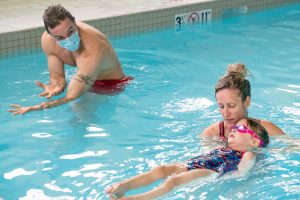‘No contact’ lessons are now required under the current phase of Quebec’s Economic Reopening Plan. The aquatic industry was just recently permitted to restart under limited conditions. Outdoor swim lessons were only just recently given the green light, as long as they follow strict guidelines put forth by the ARAQ group, which represents the aquatic industry in Quebec. For the time being, no contact swim lessons will be the new, temporary normal.
MIS has integrated all of the guidelines for swimming lessons this summer. Let’s look at each one in more detail to see what a no-contact swimming lesson looks like for your swimmer.
THE SWIM TEST
To determine the level of skill of your swimmer, all MIS instructors will conduct a swim test during your first swim lesson. The outcome will dictate which of the 2 categories below your swimmer will fall into. What’s the test? Simply put, if your swimmer can swim a pool lap without assistance or intervention they are considered “independent.”
FOR INDEPENDENT SWIMMERS
For capable swimmers looking to improve their technique and performance, a no-contact lesson means that the instructor will teach from 2 meters away (or more), preferably in the water.
Through visual, verbal, and mirroring methods instructors can teach the class. This means that they will demonstrate and talk swimmers through a skill, and provide valuable feedback from a safe distance away.
FOR BEGINNER FISHIES
For non-swimmers and beginner swimmers, a no-contact lesson is a bigger change since the swimmer requires physical support to stay afloat.
Companies are pivoting to a teaching style similar to what is used in parent & tot classes, where each child is accompanied by the parent in the water. Parents will now play a big role in the success of these lessons. They need to come in the water and take an active role in the teaching process (while learning a few skills themselves). The instructor demonstrates skills and guides the parents through how to instruct the child.
Can’t picture it? We put together a 20-second video to show you a no-contact swim lesson in action with a tiny swimmer and her mom.
WHAT’S IN IT FOR ME, THE PARENT?
We get it – you need to take a more active role in your swimmer’s development and give up time that you had typically reserved for yourself. So, what’s in it for you?
Many parents have shown support through their skepticism of this new concept, most indicating that their child learning to swim is a top priority. But there are many other fringe benefits to consider. The opportunity to bond with your child, and share incredible moments like their first swim, makes it all worth the effort in the pool.
Achieving something great with your child is an incredible experience. As a parent myself, I know the importance and triumph of reaching a new, big milestone. Remember that the milestone around your little one’s first swim is that this is the first time they learn to save their own life.
In addition, you as a parent will literally learn to become a swim instructor (sort of). While becoming a professional swim instructor requires years of certifications and experience, you will get to work alongside one, and learn how to teach skills that are critical to your child’s survival. The best part? You can continue the learning in and out of the lesson to encourage your swimmer to develop skills faster.
PARENTS HAVE ALREADY TRIED IT
Since we came up with this notion of no contact lessons and with the recent green light to outdoor lessons, MIS has been doing trials with neighbours in their at-home swimming pools, testing out the concept of a “no-contact lesson”. The feedback?
“I love it” says one father, “it’s great to know this stuff”.
“It was hard at first, but now I appreciate how important it is” says another mother.
But my favourite was from a mother following her 4-year-old daughters class:
“Thank you for such a great contact-less swimming lesson experience. I feel empowered to keep up the lessons outside our 30 minutes together! It is a fun experience for us both.”
THAT’S ALL WELL AND GOOD, BUT…
Before we wrap this up, let’s address a common question: what happens if a swimmer is in danger? The instructor will immediately provide indirect support (using a noodle, life jacket, torpedo, swim aid) or direct support to save the swimmer.
Contact is a last resort but will be made if a life-saving procedure is necessary. In the case of direct support, instructors will perform a non-face-to-face rescue where they approach from behind and turn their face away when possible.
Registration is now open for no-contact swimming lessons in at-home or indoor pools. Make sure you reserve your spot with one of our certified instructors!
Got more questions? Let us know what’s on your mind. We love talking about this stuff.
This post was originally shared on our Canada Swim School Blog but has since been adapted for Quebec and the Montreal Institute of Swimming.




